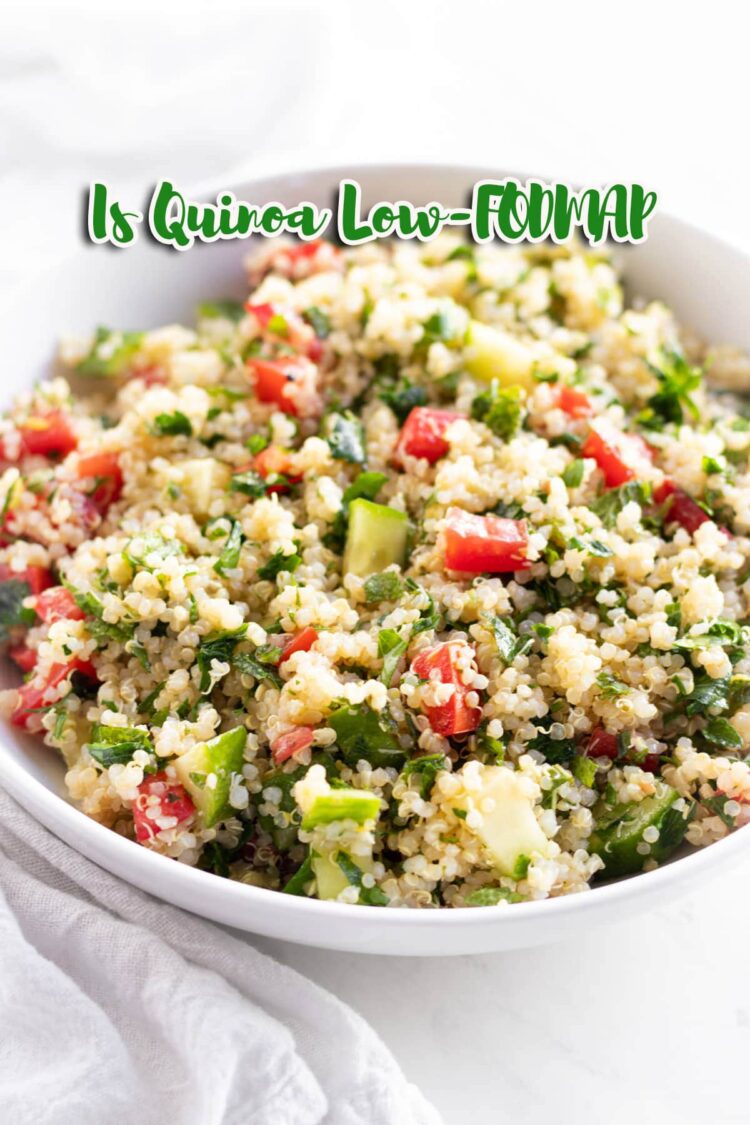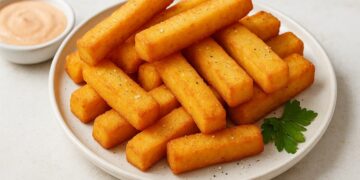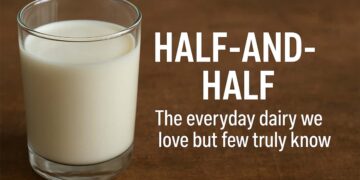Is quinoa low in FODMAP? If you’re on a low-FODMAP diet due to IBS, you may wonder about various foods, including quinoa, and whether they are high- or low-FODMAP. Quinoa is a low-FODMAP food. It’s suitable for many people. Quinoa is one of the “pseudo-grains” that you can consider adding to your diet.
I will provide a comprehensive explanation based on scientific evidence and the experiences of many people with quinoa. While I don’t have personal experience with IBS, I have developed realistic scenarios inspired by questions from dieters and guidance from clinical nutritionists. Therefore, each case scenario presented will seem humane and natural, and will be helpful for those on a low-FODMAP diet.
Why Low-FODMAP Quinoa Matters
The importance of low-FODMAP foods is that they are low in short-chain carbohydrates, which are difficult for the small intestine to digest. The negative impacts of these include excess gas, digestive upset, and discomfort. During an elimination period, low-FODMAP grains rich in fiber are often difficult to find. However, with quinoa, IBS dieters can still get the protein, fiber, and minerals from quinoa without experiencing the negative effects of short-chain carbohydrates.
Monash-aligned resources routinely include quinoa in low-FODMAP recipes and meal plans, stating that quinoa is a suitable food to consume during an elimination period.
So… is quinoa low-FODMAP?
Yes, as long as you consume it in the right amounts, quinoa can be a suitable food for IBS because it is considered low-FODMAP. Some Monash FODMAP recipes sometimes use quinoa as an ingredient, for example, in low-FODMAP pudding recipes, salads, or porridge. Well, this fact also provides accurate information about the benefits of quinoa for consumption during a carbohydrate-reduction program.
Serving Size Guidance (What Most People Actually Use)
Typically, the most common serving size for quinoa is 1 cup cooked (~155–185 g). This is still considered a low-FODMAP serving. For those with food sensitivity, you can start with 1/2 cup cooked and gradually increase it.
Tip: Portion size is crucial in adjusting a low-FODMAP diet. Even large portions of low-FODMAP foods can be problematic. Therefore, use a measuring cup when initially trying quinoa.
Nutritional Value: What You Get When Choosing Low FODMAP Quinoa
One cup of cooked quinoa (≈185 g) contains ~222 kcal, ~8 g of protein, ~5 g of fiber, and a significant amount of iron, phosphorus, and potassium. These nutrients are often lacking in many elimination diets, such as diets that only allow small portions of white rice.
Quinoa itself provides many nutrients and contains only a small amount of carbohydrates.
Why it’s helpful during a low-FODMAP phase:
Here are some reasons why quinoa is important during a low-FODMAP diet, including:
- Protein and fiber support satiety and more stable post-meal glucose.
- Minerals (iron, magnesium, and phosphorus) support energy metabolism.
- Gluten-free by nature (great if you also need GF).
Monash, an expert on IBS diets, also notes that quinoa, as a high-protein, low-FODMAP food, is excellent for supporting the health of those with Irritable Bowel Syndrome. [source]
How to use Quinoa low FODMAP in real life (3 quick frameworks)
Base + Protein + Produce
- ½–1 cup of cooked low FODMAP quinoa
- Low FODMAP protein (firm tofu, eggs, chicken, or fish)
- 2–3 low FODMAP vegetables (e.g., carrots, green beans, zucchini)
- Season with garlic oil, herbs, and citrus.
Breakfast Bowls
Quinoa flakes or leftover cooked quinoa warmed with lactose-free milk (or soy milk made with soy protein isolate), cinnamon, maple syrup, and a green-tipped banana or berries.
Make-Ahead Salad
Cook, cool, and fluff low-FODMAP quinoa; add roasted pumpkin, spinach, a few slices of cooked beetroot (watch portions), lemon, chives, and a protein. Great for work lunches.
Some Friends’ Experiences with Quona Low FODMAP
“Ayu,” The Portion Tuner
Ayu tolerated rice but wanted more nutrients. She swapped in low FODMAP quinoa at ½ cup cooked alongside grilled fish and zucchini. No symptoms. The next week, she nudged up to ¾ cup, still fine. This methodical titration (½ → ¾ → 1 cup) is a practical way to find your threshold.
“Ben,” The Breakfast Person
Ben struggles with sweet, high-FODMAP cereals. He tried a quinoa-flake porridge using lactose-free milk, cinnamon, and ⅓ firm banana. Satiated until lunch, and has minimal bloating. He kept the fruit serving modest and skipped honey, classic low-FODMAP tweaks.
Monash FODMAP
“Clara,” The Professional Meal-Prep
Clara batch-cooked low-FODMAP quinoa on Sunday, portioned 1 cup cooked into containers, and paired it with baked chicken, roasted carrots, and a lemon-herb dressing (no onion/garlic; used infused oil). Having pre-measured servings helped prevent accidental “portion creep.”
(These stories are just personal experiences of several people with health conditions. The recipes tested are Monash-style recipes and are not medical advice.)
Also see our article about: Is tomato low FODMAP?
FAQs about Is Quinoa Low FODMAP
1) Is quinoa low FODMAP for everyone with IBS?
Most people can tolerate quinoa, but this is a personal preference and results can vary from person to person. If you’re on an elimination diet, stick to standard portions (1/2 – 1 cup of cooked quinoa). For the first 3 to 5 days, keep a record of any symptoms you experience. Monash recommends consulting a dietitian and using their app to maximize results. [Monash]
2) What about quinoa flour or flakes?
Quinoa flakes are also often used in low-FODMAP breakfasts. They are considered low FODMAP in typical portions, as used in recipes by Low-FODMAP specialists. Check out the full recipe here.
3) Is quinoa good for my blood sugar while I am following a low FODMAP diet?
The protein and fiber profile of quinoa helps keep glucose levels stable after meals compared to processed grains. The article on Essential Nutrition for IBS also mentions that quinoa is an important staple for improving health. However, do not overlook appropriate portion sizes. Source: Eatingwell
Smart Shopping and Cooking Tips
These are important tips to ensure the quinoa you obtain remains low FODMAP and tender.
- During preparation, rinse thoroughly to remove saponins (these are bitter compounds that can irritate the intestines).
- Cook in a 1:2 ratio (1 cup of raw quinoa: 2 cups of water) → yields about 3 cups cooked; portion out ½–1 cup cooked per meal.
- Flavor without FODMAPs: garlic-infused oil, citrus zest, herbs, spices (cumin, paprika), ginger, or chiles.
- Batch and cool: Cooling cooked grains can enhance resistant starch, which according to some is more tender, and then reheat with a little water.
- Label-reading: Naturally, plain quinoa is gluten-free and low FODMAP. Packaged mixes may add seasonings and cause high FODMAP. Watch out for shallots or garlic, both of which can make it high FODMAP.
- Balance the plate: Combine low FODMAP quinoa with non-starchy vegetables and protein to slow digestion.
Sample 1-day Menu Using Quinoa Low FODMAP
For those of you who want to try quinoa as your food menu, follow the methods and its combination with other foods to stay on the low FODMAP track.
- For Breakfast: Quinoa-flake porridge (lactose-free milk, maple, cinnamon) + ⅓ firm banana.
- Lunch: Roasted pumpkin, low FODMAP quinoa, beetroot-slice salad with lemon-chive vinaigrette.
- Snack: Lactose-free yogurt + low-FODMAP trail mix (pumpkin seeds, a few almonds). and
- For Dinner: Pan-seared salmon, ¾ cup low FODMAP quinoa, sautéed carrots & green beans with garlic-infused oil.
- Optional dessert: Kiwi or berries within low-FODMAP serves.
Bottom line
Is Quinoa low FODMAP? Yes, as long as the portion is appropriate and according to guidelines, it is considered a low FODMAP food. It can be relied on because it is nutrient-dense, high in fiber, and does not supply excessive carbohydrates. If you want to try quinoa as part of your meals, start with 1/2 cup of cooked quinoa, and watch for any symptoms.
Then, if safe, you can increase to 1 cup of quinoa. Also, combine it with other foods that are high in protein and low FODMAP vegetables. For good flavor, use garlic oil and herbs. If in doubt, check the Monash website for the best portion recommendations. We also recommend that you involve a trained FODMAP nutritionist to select healthy foods for you.














